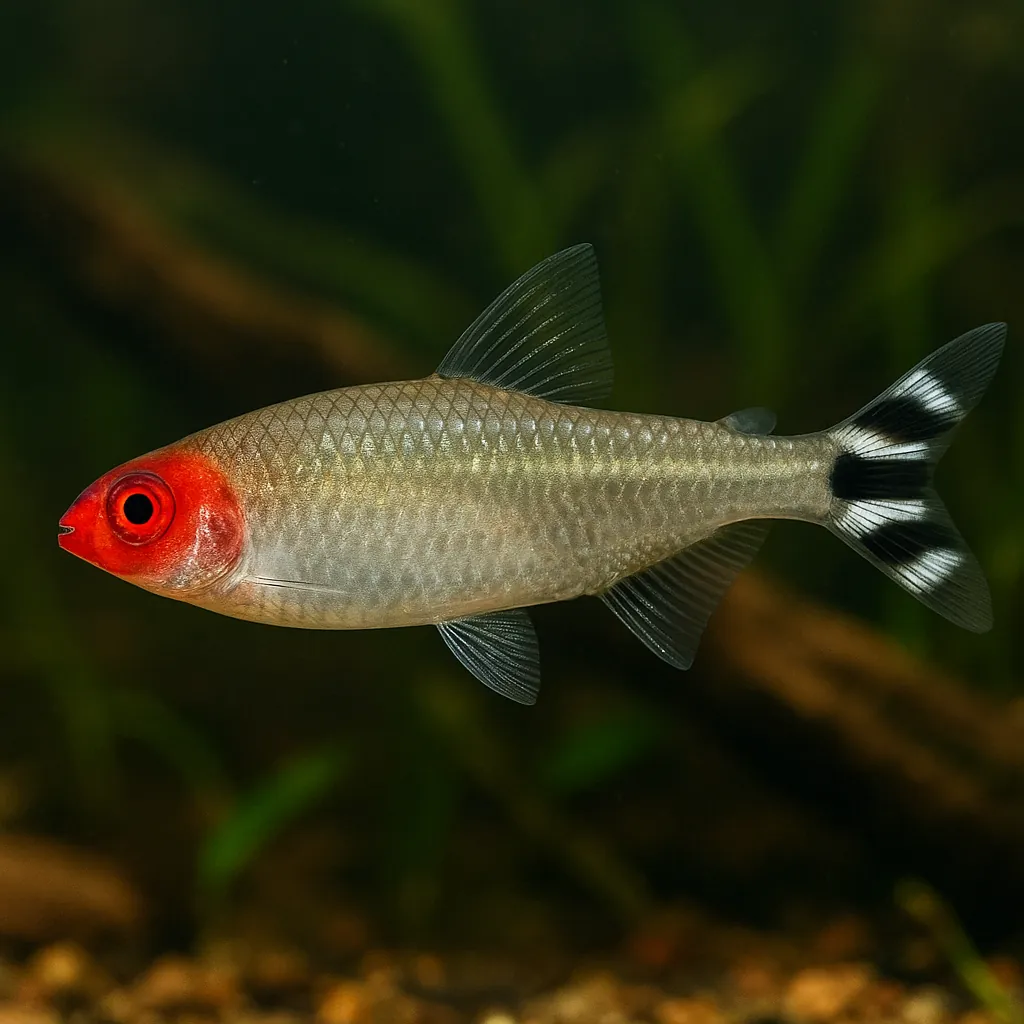
False rummynose tetra
Introduction
The False Rummynose Tetra (Petitella georgiae) is a captivating freshwater fish cherished by aquarists for its striking appearance and dynamic schooling behavior. Characterized by a silvery body, a vibrant red head, and a distinctive black-and-white striped tail, this species adds a lively touch to any aquarium. Its peaceful nature and relatively straightforward care requirements make it an excellent choice for both novice and intermediate fishkeepers.
Care and Environment
Providing optimal care for the False Rummynose Tetra involves replicating its natural habitat and maintaining stable water conditions.
What is the minimum tank size for a False Rummynose Tetra?
A minimum tank size of 80 liters is recommended to accommodate a small group, as these fish thrive in schools and require ample swimming space.
What are the ideal water parameters for False Rummynose Tetras?
Maintain a temperature between 22°C and 26°C, a pH range of 5.5 to 7.0, and water hardness between 1 to 12°H to ensure their well-being.
How should the aquarium be set up for False Rummynose Tetras?
Incorporate fine-leaved plants, driftwood, and a dark substrate to mimic their natural environment. Subdued lighting and gentle water flow are also beneficial.
Filtration should be efficient yet gentle to prevent strong currents. Regular water changes are crucial, as these tetras are sensitive to fluctuations in water quality. For feeding, offer a varied diet including high-quality flake foods, micro pellets, and live or frozen options like brine shrimp and daphnia. Feed small portions 1–2 times daily, ensuring all food is consumed within a few minutes to maintain water quality.
Origin and Habitat
Native to the upper Amazon River basin in Peru, the False Rummynose Tetra inhabits whitewater tributaries such as the Purus, Negro, and Madeira River basins. These environments are characterized by soft, acidic waters with temperatures ranging from 22°C to 26°C. The natural habitat features dense aquatic vegetation and gentle water flow, providing ample hiding spots and a rich supply of food sources. Mimicking these conditions in the aquarium is essential for the health and vibrancy of the species.
Temperament and Compatibility
The False Rummynose Tetra is a peaceful, schooling fish that thrives in groups of at least ten individuals. Keeping them in sufficient numbers promotes natural behavior and reduces stress.
Are False Rummynose Tetras suitable for community tanks?
Yes, they are ideal for community aquariums when housed with other peaceful species of similar size.
What are suitable tank mates for False Rummynose Tetras?
Compatible companions include small tetras, pencil fish, dwarf cichlids like Apistogramma, Corydoras catfish, and small Loricariids.
Are there any tank mates to avoid?
Avoid housing them with boisterous or much larger species, as they may outcompete the tetras for food or cause stress.
Providing a well-planted tank with ample swimming space and hiding spots will help create a harmonious environment for these tetras and their tank mates.
Interesting Facts
The False Rummynose Tetra is often confused with its close relatives, the True Rummynose Tetra (Hemigrammus rhodostomus) and the Brilliant Rummynose Tetra (Hemigrammus bleheri). One distinguishing feature is the extent of the red coloration on the head; in P. georgiae, the red does not extend past the gill plate, whereas in H. bleheri, it does.
How can you differentiate between False and True Rummynose Tetras?
The False Rummynose Tetra has a red head that does not extend past the gill plate, while the True Rummynose Tetra's red coloration extends further.
What is unique about their schooling behavior?
They are known for their tight schooling behavior, often moving in unison, which adds a dynamic visual appeal to the aquarium.
Are False Rummynose Tetras sensitive to water quality?
Yes, they are sensitive to water quality and can lose their vibrant coloration if conditions deteriorate, making them good indicators of water quality.
These tetras are also known to be sensitive to water quality, often losing their vibrant coloration if conditions deteriorate, making them good indicators of water quality in the aquarium.
Sources
All information in this article has been gathered from the following reputable sources:
Overview
Recommended Tank Size 26.4 Gallons (for groups of 10 or more) |
Minimum Group Size 10 |
Minimum Tank Volume 21.1 Gallons |
Maximum Adult Length 1.5 inches |
Average Adult Length 1.4 inches |
Shoaling (6+ required) Yes |
Preferred Water Type Freshwater, soft, acidic |
Temperature Range (°C) 22–26 |
pH Range 5.5–7.0 |
Water Hardness (dGH) 1–12 |
Typical Lifespan (years) 3 years |